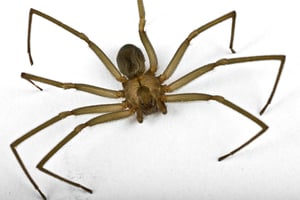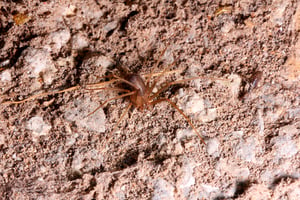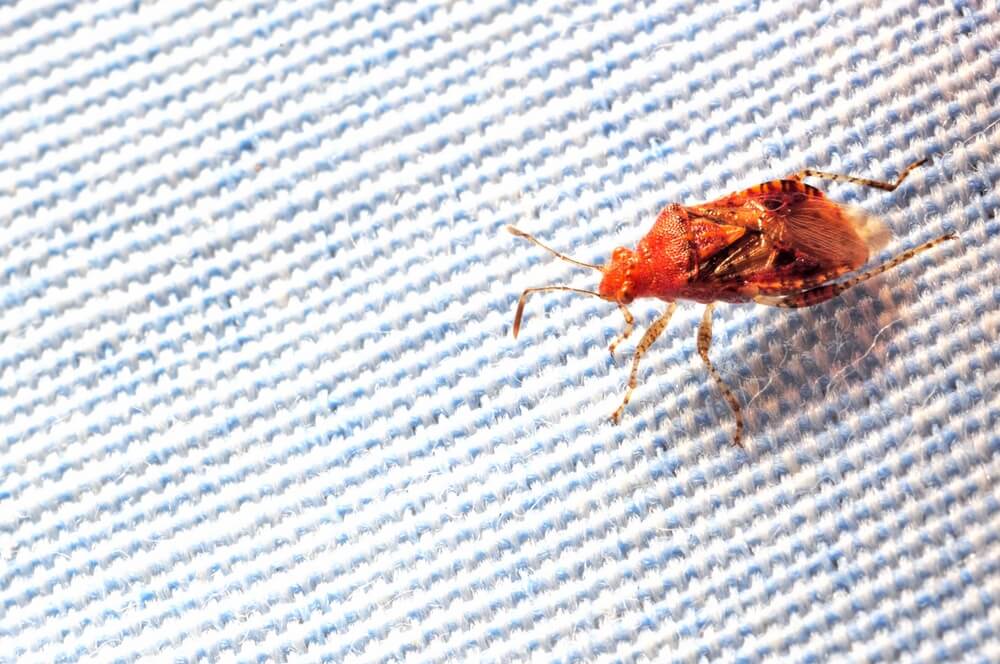What does the Brown Recluse spider look like?
 The Brown Recluse spider’s name refers to its coloration and the fact that it’s quite shy. Brown Recluse spiders vary in size, but they’re usually around the size of a quarter. Their bodies are a uniform tan to dark brown, with no striping or banding. Occasionally, the spider’s abdomens, heads, and legs may be slightly different shades. Brown Recluses’ legs are long and thin.
Brown Recluse spiders are sometimes nicknamed “violin” spiders because of a distinctive marking on their backs. This marking is usually located on the top of the spider’s front body section. It will be darker than the rest of the spider’s body. The “neck” of the violin will point toward the spider’s rear. The size and shape of the mark varies from spider to spider. Brown Recluse spiders also have six eyes, not eight like most spiders, though it can be hard to tell without a magnifier.
The Brown Recluse spider’s name refers to its coloration and the fact that it’s quite shy. Brown Recluse spiders vary in size, but they’re usually around the size of a quarter. Their bodies are a uniform tan to dark brown, with no striping or banding. Occasionally, the spider’s abdomens, heads, and legs may be slightly different shades. Brown Recluses’ legs are long and thin.
Brown Recluse spiders are sometimes nicknamed “violin” spiders because of a distinctive marking on their backs. This marking is usually located on the top of the spider’s front body section. It will be darker than the rest of the spider’s body. The “neck” of the violin will point toward the spider’s rear. The size and shape of the mark varies from spider to spider. Brown Recluse spiders also have six eyes, not eight like most spiders, though it can be hard to tell without a magnifier.
Where does the Brown Recluse live?
 Brown Recluse spiders are native to a wide portion of the mid-to-southern United States. They’re relatively common anywhere within their distribution range, but very rare outside of that range. The further north you live, the lower the chance that you will encounter a Brown Recluse. Within Plunkett’s service area, Brown Recluses live in Kansas, Missouri, Kentucky, and southern Illinois, Indiana, and Iowa. They’re especially common in Missouri.
Within its range, the Brown Recluse likes living in dark, secluded spaces and are often attracted to man-made structures like porches, closets, and garages because of the darkness and cover they provide. Outside, they usually live under rocks, logs, wood piles, or other natural debris. Brown Recluses are nocturnal, so they don’t move around much during the day. Often, Brown Recluse spiders inadvertently travel when people move the boxes and bags they’re hiding in.
Brown Recluse spiders are native to a wide portion of the mid-to-southern United States. They’re relatively common anywhere within their distribution range, but very rare outside of that range. The further north you live, the lower the chance that you will encounter a Brown Recluse. Within Plunkett’s service area, Brown Recluses live in Kansas, Missouri, Kentucky, and southern Illinois, Indiana, and Iowa. They’re especially common in Missouri.
Within its range, the Brown Recluse likes living in dark, secluded spaces and are often attracted to man-made structures like porches, closets, and garages because of the darkness and cover they provide. Outside, they usually live under rocks, logs, wood piles, or other natural debris. Brown Recluses are nocturnal, so they don’t move around much during the day. Often, Brown Recluse spiders inadvertently travel when people move the boxes and bags they’re hiding in.
Is the Brown Recluses’ venom dangerous?
 It can be. Brown Recluse venom is very potent. When injected via a bite, it destroys cell membranes, leading to the breakdown of skin, fat, and blood vessels. Ultimately, this triggers the death of surrounding affected tissue (this process is called necrosis). Fortunately, however, most Brown Recluse bites remain localized and cause little tissue damage. The venom makes the site red, swollen, and tender, but symptoms clear within three weeks without medical intervention.
Occasionally, however, Brown Recluse bites can inflict significant or even life-threatening damage. Bites may cause severe pain, ulcers, fever, chills, nausea, joint pain, or even seizures. If you believe you’ve been bitten by a Brown Recluse spider, you should see a doctor ASAP. There is no antivenom for Brown Recluse bites, but they can assess your risk and treat symptoms as they occur. Medical attention is especially important if necrotic lesions develop, to avoid dangerous secondary complications.
It can be. Brown Recluse venom is very potent. When injected via a bite, it destroys cell membranes, leading to the breakdown of skin, fat, and blood vessels. Ultimately, this triggers the death of surrounding affected tissue (this process is called necrosis). Fortunately, however, most Brown Recluse bites remain localized and cause little tissue damage. The venom makes the site red, swollen, and tender, but symptoms clear within three weeks without medical intervention.
Occasionally, however, Brown Recluse bites can inflict significant or even life-threatening damage. Bites may cause severe pain, ulcers, fever, chills, nausea, joint pain, or even seizures. If you believe you’ve been bitten by a Brown Recluse spider, you should see a doctor ASAP. There is no antivenom for Brown Recluse bites, but they can assess your risk and treat symptoms as they occur. Medical attention is especially important if necrotic lesions develop, to avoid dangerous secondary complications.
Should I be worried about the Brown Recluse?
 Not as much as you probably think you should be. Although about 10% of Brown Recluse spider bites can be very serious, the spider very rarely bites a human. The Brown Recluse is very shy. They avoid human contact whenever possible and live in places where they won’t be discovered. Even if Brown Recluse spiders do live in your home, there’s a good chance they’ll never bite you.
Brown Recluse spiders and bites are also significantly over-reported. In 2005, the University of California’s Entomology department requested people send them specimens they thought were Brown Recluses. Of the 1,773 spiders they received, less than 20%--324--were Brown Recluse spiders. Likewise, Brown Recluse spiders don’t bite nearly as frequently as people tend to imagine they do--even if they are nearby. In one extreme example, scientists collected 2,055 Brown Recluse spiders from an occupied house in Kansas. Despite how many spiders lived among them, not one of those spiders ever bit the home’s occupants.
We’re not trying to say you’re silly for being afraid of the Brown Recluse spider. Spider bites are frightening, unpleasant things to think about--especially when they can do some serious damage. Ultimately, though, the Brown Recluse isn’t the serious, terrifying threat to your safety it’s sometimes made out to be.
If you think you’ve been bitten by a Brown Recluse, see a doctor ASAP. Try to collect the spider that bit you and bring it along for identification. Otherwise, don’t spend too much time worrying about the Brown Recluse. If you can’t help it, however, you can always call Plunkett’s. We can make sure your home doesn’t have a spider infestation and help you keep it that way.
Not as much as you probably think you should be. Although about 10% of Brown Recluse spider bites can be very serious, the spider very rarely bites a human. The Brown Recluse is very shy. They avoid human contact whenever possible and live in places where they won’t be discovered. Even if Brown Recluse spiders do live in your home, there’s a good chance they’ll never bite you.
Brown Recluse spiders and bites are also significantly over-reported. In 2005, the University of California’s Entomology department requested people send them specimens they thought were Brown Recluses. Of the 1,773 spiders they received, less than 20%--324--were Brown Recluse spiders. Likewise, Brown Recluse spiders don’t bite nearly as frequently as people tend to imagine they do--even if they are nearby. In one extreme example, scientists collected 2,055 Brown Recluse spiders from an occupied house in Kansas. Despite how many spiders lived among them, not one of those spiders ever bit the home’s occupants.
We’re not trying to say you’re silly for being afraid of the Brown Recluse spider. Spider bites are frightening, unpleasant things to think about--especially when they can do some serious damage. Ultimately, though, the Brown Recluse isn’t the serious, terrifying threat to your safety it’s sometimes made out to be.
If you think you’ve been bitten by a Brown Recluse, see a doctor ASAP. Try to collect the spider that bit you and bring it along for identification. Otherwise, don’t spend too much time worrying about the Brown Recluse. If you can’t help it, however, you can always call Plunkett’s. We can make sure your home doesn’t have a spider infestation and help you keep it that way.







